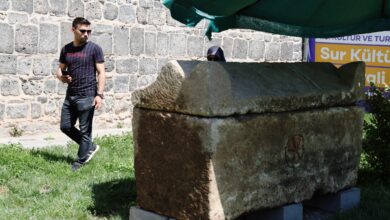
Germiyan Bey II. This building, which is the soup kitchen of Yakub Bey (1387-1429) Kulliye, was restored by the Ministry of Culture and Tourism and opened to visitors on March 5, 1999 as the Tile Museum. Two rooms with domed iwans open in three directions, with a dome and a fountain in the middle. In the tomb section II. Yakub Bey has a tiled sarcophagus. The basic inscription of the complex is located to the left of the entrance door.

There are tile works from the 14th century to the present day in the showcases in the museum. The central space of the museum with a domed and a fountain, a three-sided domed iwan and two rooms is XIV. Examples of Kütahya and Iznik tiles that have survived from the 16th century, materials used in making tiles, paints, brushes and patterns are exhibited. In addition, the old tiles donated to the museum by Rifat Cini are in a separate section named after his father Mehmet Cini. The china plates that won the competitions in Kutahya and an old fountain inscription dated 1921 are also exhibited here. The building was named Goksadirvan because of the monolithic marble fountain inside.

Two rooms with domed iwans open in three directions, with a dome and a fountain in the middle. The tomb section is made of cut stone and there is a tiled sarcophagus of Yakup Bey, who left his lands to the Ottomans. At the beginning of the 20th century, when the Great Mosque was closed for repairs, a mihrab was added in front of the mausoleum so that prayers could be performed here. The stone foundation epitaph of the madrasah, which was next to the soup kitchen and was destroyed in the 1960s, was placed in the niche to the south of the entrance door. The inscription consisting of 39 lines was written in Ottoman Turkish. On it, the places that Germiyanoglu 2. Yakup Bey donated, the fees to be given to the officials here and how to treat the guests coming to the madrasah are indicated.

FLOWERS THAT BLEED IN FIRE
In the showcases of the museum, there are examples of tiles made today starting from the 14th century and described as “flowers blooming on fire” by the Kutahyans. These tiles, made by hand with a single brush, are like works of art. The silver seal of the tile master Hafiz Mehmet Emin was donated to the museum by his grandchildren, and the tile coffee table, which is Hafiz Mehmet Emin’s own work, is exhibited in the museum. Inside the museum, in the room on the right iwan, there are the oldest Kütahya tiles and samples of materials, paints, brushes and patterns used in making tiles. These materials inform visitors about how tiring tile making is.

CUP MAKERS’ AGREEMENT
An example of the Fincancilar Agreement, which is the first collective bargaining agreement in history, signed in Kutahya in 1766 and whose original is in the Ankara National Library, is exhibited in the museum. In the agreement signed in the presence of the Governor Ali Pasha, it was stated that no other business could be opened except for 24 workplaces, and the salaries of the vessel master, journeyman and apprentice were written one by one. It is stated that those who do not comply with this agreement will be sentenced to death.







This Tile Museum Looks fascinating. I cannot find any up to date information about it. Are you able confirm that it will be open in November 2023? I understand it is closed on Mondays.
thank you.